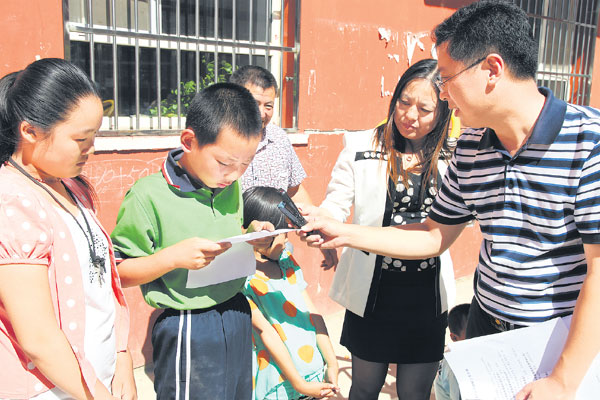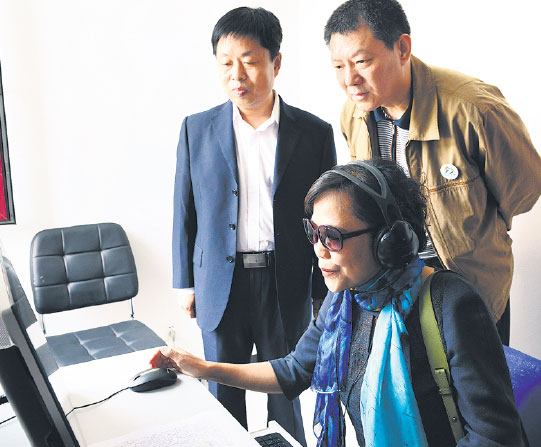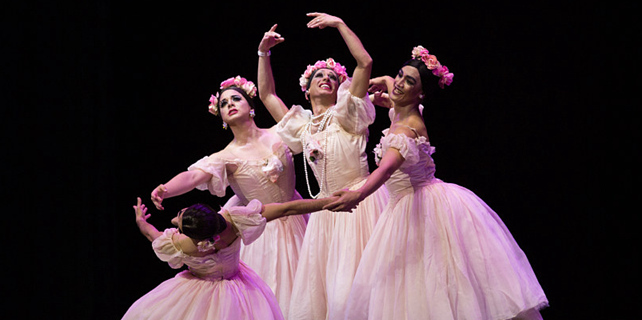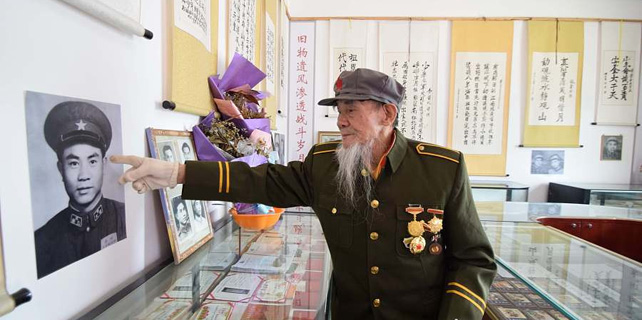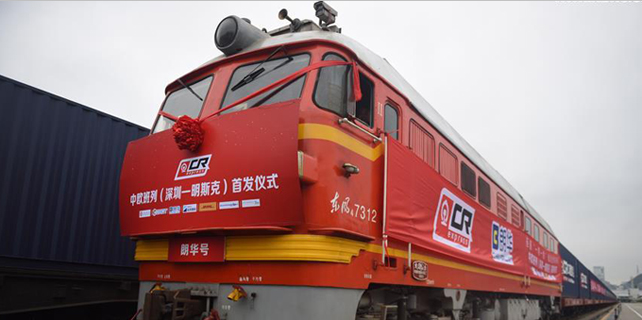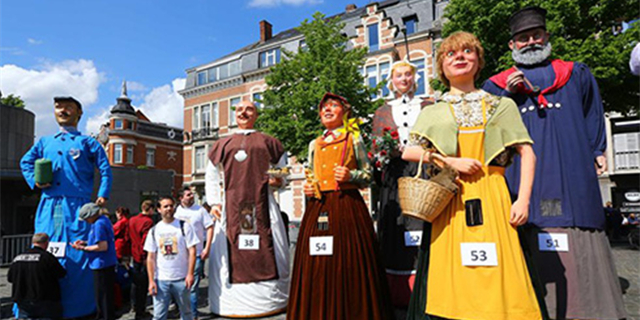Putonghua push puts local dialect in spotlight
The government's decision to raise the number of people who speak the country's official, standardized language has drawn attention to a small county in North China, as Zhang Yu reports from Chengde, Hebei province.
About 1 billion people in China speak Putonghua, the national, standardized form of Mandarin, as their mother tongue. Although those people account for more than 70 percent of the population, the government has decided that the number will be raised to 80 percent by 2020.
A blueprint released last month detailed the changes, including the requirement that some professionals, such as teachers, will have to pass oral tests in Putonghua before they can be appointed to a post.
While the plan has attracted attention nationwide, it has also focused the spotlight on Luanping, a small, mountainous county in Hebei province, where the local dialect shares so many similarities with China's official language that the residents often tell stories that express their pride at living in the "home of Putonghua".
Probably the most famous tale concerns identical twins whose parents divorced, resulting in the boys being separated and sent to live in different parts of the country.
The older boy lived with his father in Qingdao, a city in Shandong province, about 650 kilometers southeast of Beijing. The younger sibling lived with his mother in Luanping, about 150 km northeast of the capital.
The boys looked so similar that even their parents were unable to tell them apart. However, by the time they were approaching adulthood, they were easily distinguishable - not by their appearance, though, but because they spoke different dialects.
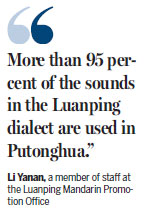
The older brother spoke the Shangdong dialect, which is almost unintelligible to outsiders, and learned Putonghua at school. The younger brother spoke the Luanping dialect, which sounds almost exactly like Putonghua.
Although the boys still looked identical, they could be distinguished from the way they spoke.
Hao Zongju, a Luanping native, often tells that story when she attempts to convince friends who have never visited the county that her native dialect is the bedrock of the modern official language.
"Our linguistic environment can assimilate everybody who lives in the county for a long time," Hao said.
She added that many Luanping natives exploit their linguistic advantage to gain work as receptionists, broadcasters, attendants and tour guides.
Bedrock language
In 1953, the government dispatched a group of linguists to locations nationwide to record speech patterns, and to identify dialects that were easy to understand and could be standardized as the country's official spoken language.
Luanping was one of the places the experts visited.
They decided to use the local dialect as a main reference point for establishing a standard for official spoken Chinese, according to Wang Guoping, a senior historical researcher with the Luanping Committee of the Chinese People's Political Consultative Conference.
In 1955, China's standard spoken language was born. It was named Putonghua, or "common speech", because it was intended to be understood nationwide.
It was mainly based on the pronunciation used by speakers of northern dialects, especially the one spoken in Luanping.
According to the Luanping Mandarin Promotion Office at the county education bureau, the phonetic similarities between the Luanping dialect and modern Mandarin are striking.
"More than 95 percent of the sounds in the Luanping dialect are used in Putonghua," said Li Yanan, who works at the office, but is also a guide at a museum dedicated to both the local dialect and the official language.
For example, Putonghua has 22 initial consonants, while the Luanping dialect has 23, and 22 of them are the same as in Putonghua.
Despite the backing of expert opinion, Hao sometimes finds it difficult to convince people of the validity of her claim.
Even now, more than 60 years after the standard was introduced, many people don't understand why residents of Luanping, far from the capital, appear to speak fluent, clearly articulated Putonghua and sound more natural than Beijing natives, who are often regarded as the benchmark for pronunciation and articulation, she said.
Origins
Luanping is located in Hebei's Chengde city, which lies adjacent to Miyun district in northeastern Beijing, about three hours from the capital by road.
In the early 15th century, Emperor Zhu Di of the Ming Dynasty (1368-1644), also known as the Yongle Emperor, moved the national capital from Nanjing, in East China's Jiangsu province, to Beijing.
At the time, Nanjing-accented Mandarin was the official language of the court and administration, but there was no standardized spoken form for common people.
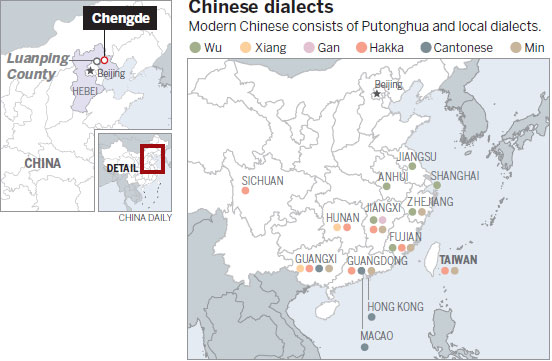
To strengthen the defenses of the new capital, the emperor ordered all the troops and inhabitants of villages outside the Jinshanling Great Wall - located on the current border between Miyun and Luanping - to move within the city walls.
The forced migration left Luanping a "no-man's land" until the early years of the Qing Dynasty (1644-1911), when the Emperor Kangxi dispatched high-ranking officials to develop the abandoned land, according to Wang, the researcher.
The area had been uninhabited for more than 200 years, and as a result the ancient dialect spoken in old Luanping had died out.
A blank sheet
"The land was like a blank sheet of paper when the government officials reoccupied it," Wang said.
He added that the officials and their descendants constituted the original residents of modern-day Luanping, who were ordered to speak Classical Chinese, the language promoted during the early period of Qing rule, and was the predecessor of modern Mandarin and, subsequently, Putonghua.
According to Wang, Classical Chinese, rather than the dialect spoken by the natives of Beijing, was handed down through the generations in Luanping.
"It (the local dialect) has profound historical origins. That's why Luanping natives speak the old standard official language, which was the predecessor of Putonghua," he said.
Although, the Luanping dialect is similar to Putonghua, it is not identical because standards for the old official language were revised several times following the fall of the Qing in 1911.
"The pronunciation of a number of words is different," Wang said, adding that, even so, the language spoken by Luanping residents easily meets the national standard for spoken Putonghua.
However, the same cannot be said for all residents of modern Beijing, he said.
The Beijing dialect does not equate to standard Putonghua because its predecessor lost many elements endemic to classic Beijing speech.
Those elements include the heavily rolled "r" that is added to many words that officially end in "n", a characteristic known as erhuayin, according to Wang.
"However, modern Beijing is a melting pot where different kinds of spoken language gradually get mixed together," he said.
"That's why the Luanping dialect probably sounds closer to standard Putonghua than regular Beijing speech, which is why we call Luanping 'the home of Putonghua'."
Contact the writer at zhangyu1@chinadaily.com.cn
China's official spoken languages through the ages
The Spring and Autumn Period (770-476 BC): Ya Yan
The Han Dynasty (206 BC-220): Tong Yu
The Ming Dynasty (1368-1644): Guan Hua
The Minguo Era (1912-1949): Guo Yu
Since 1955: Putonghua (aka modern, standardized Mandarin)
Source: Hebei Daily
|
An expert from the State Language Commission collects samples of the dialect in Luanping county, Hebei province. Photos By Huo Tengda For China Daily |
|
A woman uses a system designed to assess the accuracy of spoken Putonghua. |
(China Daily USA 05/23/2017 page6)







